“How to Facilitate Healthy & Respectful Conversations (Online & Off)” is an interactive online workshop for educators that we offered in March 2021. It featured Vermont educator Kathy Cadwell and six of her students at Harwood Union High School, in Moretown VT.
In this workshop, Katherine Cadwell and her students shared their experiences addressing the specific challenges of planning for and facilitating successful virtual discussions. The students described how to create a functional classroom climate, how young people can work with teachers to set norms for online dialogue, and techniques and strategies to facilitate virtual discussions.
They confront some of the most common roadblocks to healthy & respectful discussions, and learn the norms students recommend for removing them — or better yet, preventing them even starting. We’ll also look at some tech tips for creating engaging and functional online spaces for these dialogues. How can we work with our students to engage in virtual discussions that are highly engaging and grounded in mutual respect, collaboration and trust?
Below please find a recording of the workshop, optimized for solo or team playback.
The workshop itself contains prompts for reflection, as well as an activity involving an excerpt from Robin DiAngelo’s White Fragility: Why It’s So Hard for White People To Talk About Racism.
We encourage you to listen to these materials as a solo practitioner, or with your teaching team. Below, you’ll also find a transcript of these materials, annotated with the resources cited.
All materials presented here are licensed via Creative Commons 4.0 (Non-Commercial) license. You may re-use them, and re-mix them for non-commercial usage, with attribution.
Recording

Audio-only version
Resources
- Slides for How to Facilitate Healthy & Respectful Conversations online
- What Are the Qualities of A High Quality Discussion? (Google Doc)
- Tech Tips for Creating Engagement & Deepening Online Discussions (Jamboard)
Transcript
Kathy Cadwell: I’m here with several wonderful students. Six wonderful, highly talented students that I have worked with at Harwood, to share a journey that we’ve been on and what we know about how to have high quality in-person conversations — especially how to have high quality conversations online. And the students are really going to be leading much of this workshop and they’re going to be facilitating a small online discussion.
We invite everyone to join in and we’ll be sharing the practices that we’ve learned to adopt as we go along.
Today, we are really gonna hone in on this question of how can we create virtual classrooms that are highly engaging and grounded in mutual respect, collaboration, and trust.
Meet Your Instructors
Merry Smith: So we are all Harwood students. And last year, we were all part of a class with Kathy Cadwell that focused on classroom dialogue through the Harkness pedagogy.
And we were having lots of discussions and presenting around the state when COVID happened, and we decided to try to have discussions online. Most of this presentation is based on what we learned during those months after March.

So I’m Merry Smith. This is my second year working with Kathy Cadwell on all this work. And in my spare time, I also like to play field hockey and I’m also a ski instructor during the winter and the season just finished out and that’s me on the left with the student that I got to work with this year. So it was really fun. Yeah.
Maia George: Hi, I’m Maia George. I’m a junior at Harwood. I’ve been involved in Harkness for two years with Kathy and I’ve been helping her teach some courses this year on dialogue, which has been really fun.
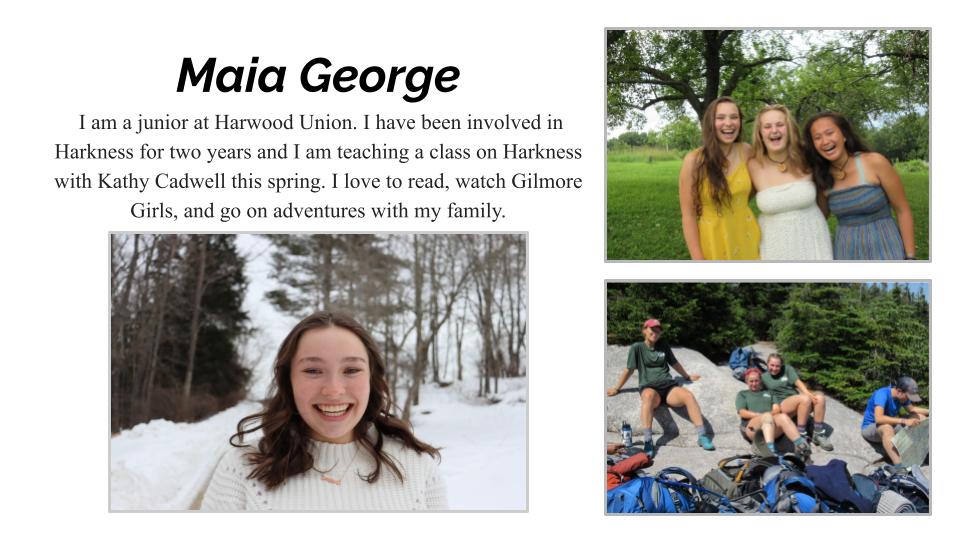
When I’m not at school, I like to watch Gilmore Girls with my sister. Here, you can see me on a hike at camp.
Jaye Fuller: Hi everyone. My name is Jaye Fuller. I’m 17 years old and I’m a junior at Harwood Union High school. Throughout my years of high school, I’ve become super passionate about students advocating for their own education. And because of this, I love being involved in the craziness of the Hartness pedagogy, where students drive the conversation.
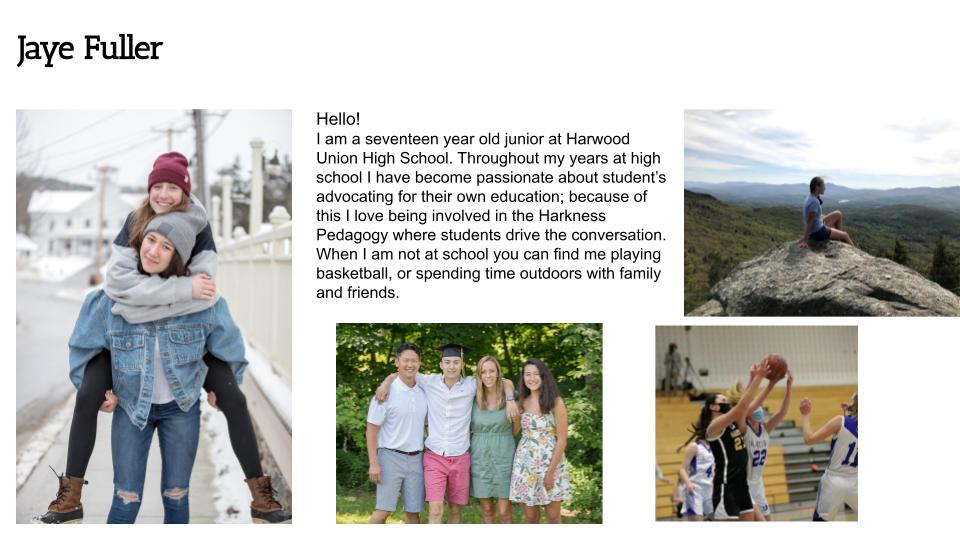
When I’m not in school, you can find me playing basketball training as barista at PK Coffee, and spending time outdoors with family and friends.
Anna Albertini: Hi guys, I’m Anna Albertini, and I’m so excited to be here today. So, I am a junior at Harwood Union High School, and this is also my second year. I’m working with Kathy on Harkness when I’m not in school. I love to travel. And I also intern at a law office in Waterbury VT.
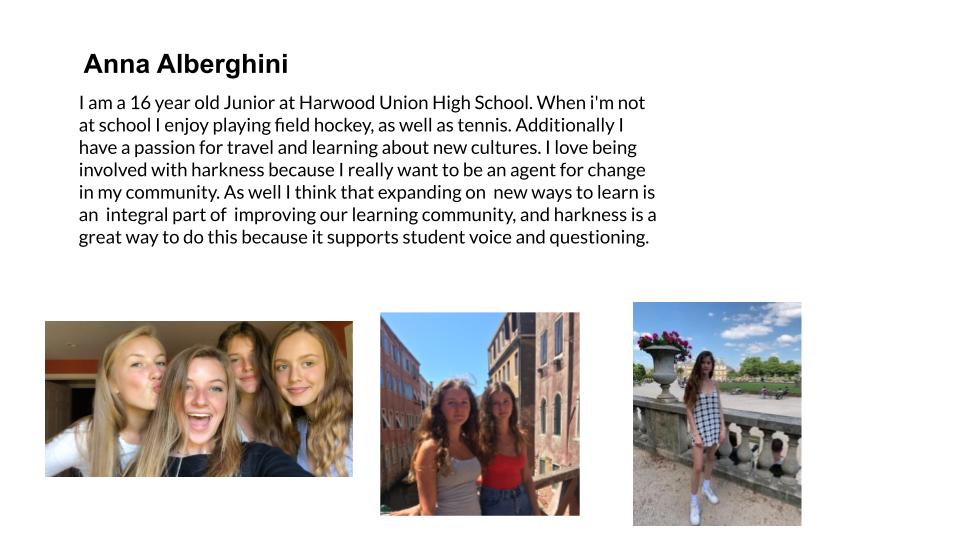
And I really love Harkness because I love expanding on new ways to learn and helping integrate that into my school community.
Allie Brooks: My name is Allie Brooks. I am also a junior at Harwood. In my free time, I love to play field hockey, sing, and spend time with my family and friends.
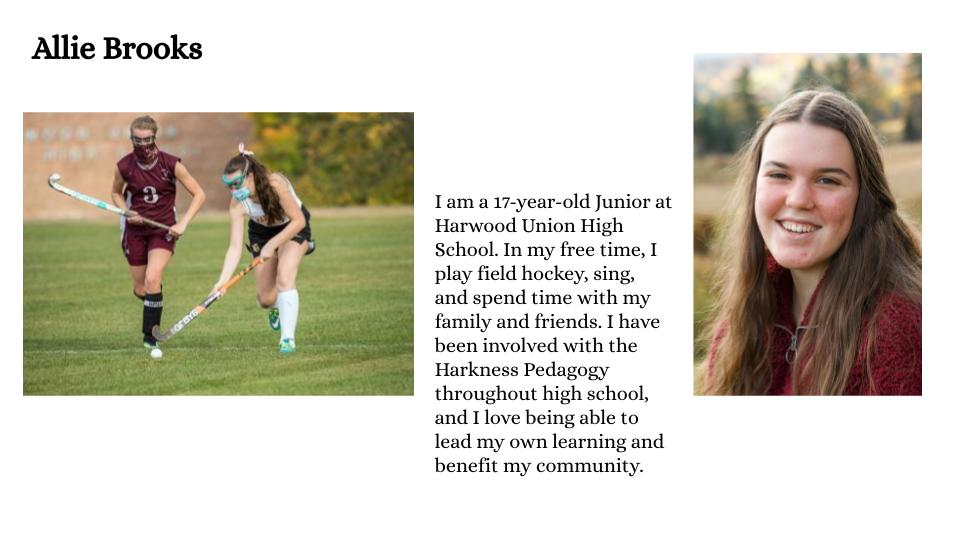
I took that class with Kathy last year and ever since then, I’ve been really involved in the Harkness pedagogy at Harwood. And I love the opportunity to kind of take charge of my own learning and help other students do that as well.
Mason Berry: I’m Mason, I’m a senior, I’ve been working with Harkness in and out of the strategies class since sophomore year. I’ve really come to believe in the main concept of Harkness, which is: the one that does the work, does the learning.
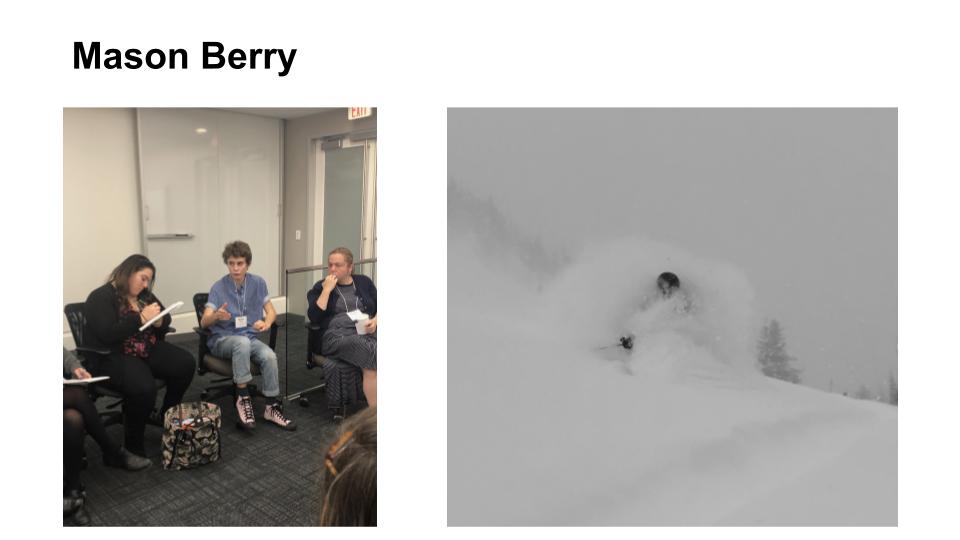
And I want to like continue spreading that after I’m out of Harwood.
Where to start with building online conversation spaces
Kathy: Thanks Mason. So you heard these students mentioned the term Harkness or the Harkness pedagogy. That’s a particular type of learning where students work together to drive the conversation. This workshop is really not about Harkness.
We’re really going to be sharing our experiences about how to have high quality discussions face-to-face and most specifically, online. We’re going to be sharing some general principles that we have just learned.
Now, these are words that really have resonated with me:
“The foundation of all high quality discussion is based on relationships and trust.”
And Brené Brown says, “Trust is earned in the smallest of moments.”
When we think about developing trust in our classrooms, and a climate of collaboration and safety, where kids feel comfortable taking risks? That’s the foundation of all successful and high quality dialogue.
And this sort of dialogue, I think demands new roles for students and teachers.
One of the things that’s important to think about with online dialogues is what are the obstacles, because there are definitely some new things that have come up in the past year that have made it a little bit harder to discuss these topics in an online classroom setting.
There are certainly advantages, but we’re going to start off with this short video of Harwood teachers showing some obstacles to an online discussion.
Have you ever seen any of these behaviors before?

Merry: So one exercise we’re gonna do is we want to know what challenges you as teachers have encountered using online discussions. And we’d like you to put them in the chat, like think of just a few comments or something that you thought of that video, something you’ve experienced in your virtual classroom.
From the chat:
- “I start talking and forget to unmute.”
- “I can hear students talking to each other on Facebook.”
- “Students who leave immediately after attendance.”
- “Little siblings bombing the class.”
- “Multiple people trying to talk at the same time.”
- “Pets are wonderful, but sometimes distracting.”
- “Students not turning on their cameras.”
- “It’s difficult to read body language when talking about tough topics.”
- “Glitching screens!”
- “Students are in chaotic environments that cause disruptions when they try to ask questions.”
- “Teachers not being aware of why students choose to keep their cameras off.”
- “I feel all alone sometimes.”
Kathy: As you’re scrolling through these, do you see anything that you haven’t written, but that that resonates with your experience? l
When we operate in an online world, it really is a new world.
Challenges… from the students’ perspective
Kathy: This is a list that kids created to share with teachers what’s hard for them.
Anna: So, the first thing that we noticed when we were brainstorming challenges that we had experienced while having online discussions was that speaking up online can be more difficult.
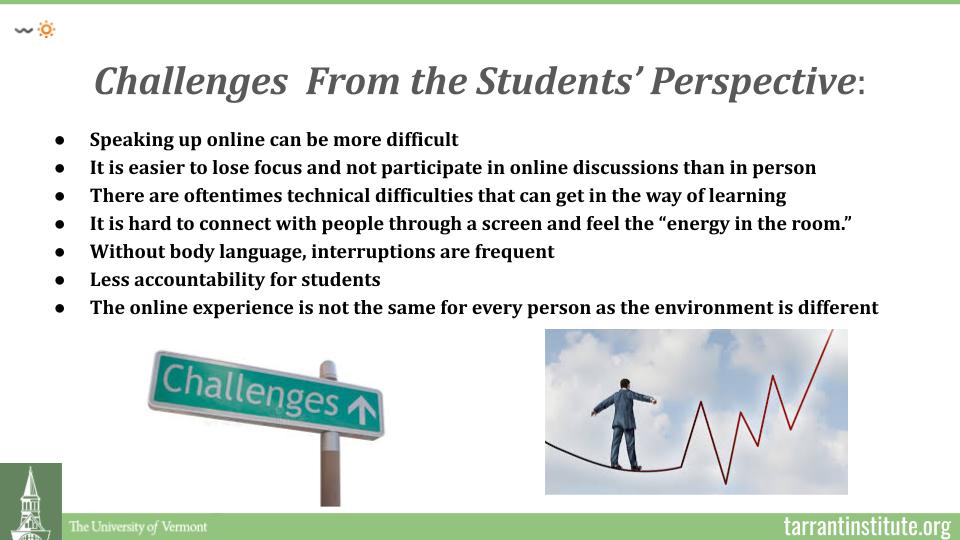
I think that when you have like a barrier of technology, it can definitely be like a little bit more nerve-wracking. It adds a lot of extra challenges just on top of already, like, speaking out in a group can sometimes be really scary for a lot of students.
Jaye: It is immensely easier to lose focus and not participate in online discussions than it is in person. I don’t know about you guys, but I have a Macbook as my computer. So like, if I see a message pop up it’s super easy to just turn and want to respond to my message rather than zeroing in on what’s going on in the discussion.
Anna: There are sometimes technical difficulties that can get in the way of learning. Almost like every zoom I’m in, you know, it’s a big, big challenge that we face.
Jaye: It is hard to connect with people through a screen and feel that energy in the room. During a discussion in person, you can definitely like feel the energy start to build and pick up. And it’s a lot harder through the screen, which then can cause people to be nervous or not focus. And just the loss of energy sometimes is a huge challenge that students face.
Anna: So this one, I think is a real, real big challenge, especially when we’re having active discussions. And that is, without body language, interruptions are frequent.
Through the screen, you can’t really see when people are like leaning in to speak up into a discussion. So that makes it so interruptions are a lot more frequent because we can’t read each other’s body language.
Jaye: Another one is there’s less accountability for students. This is a huge one, because students have to become accountable to themselves and say, “You know what, this is a time where I’m going to focus and I’m going to drive my own learning.”
Whereas in a classroom, you know, you’re accountable to your teacher.
Who’s like standing right there. And watching you.
Through Zoom, the teacher’s watching you, but you can have your camera off. So there’s just less boundaries and less accountability. It really turns the focus to the student and drives the student to say: hey, I want to drive my own learning.
Anna: So the next one is the online experience is not the same for every person as the environment is different. So opposed to being in a one classroom altogether, I think it’s a big challenge that everyone’s in a different environment and their distractions, their workspace may be different. That definitely makes it difficult.
What happens in a high quality discussion?
Kathy: Thank you, Anna and Jaye. We might compare this with our list that we just brainstormed. There are certainly some overlaps and yet some very different challenges when you’re a student in an online classroom, rather than if you’re a teacher.
Now, let’s move towards what happens in a high quality discussion.
We want to invite you to think for a minute and visualize when you are in a high quality discussion face-to-face or online.
What do you see? And what do you see happening?
What do you hear? What sorts of comments do you hear student to teacher, student to student, for example, and what would you, how would you characterize the emotional tone or climate of the classroom?
We’re inviting everyone to write in to this Google Doc, and let us know your experiences.
Really focus on specifics.
- What does it look like?
- What does it sound like?
- And what sorts of comments are you getting?
- What’s the emotional tone of the classroom or the climate of the classroom?
We saw in the video spoof some of the behaviors that maybe we don’t want to see in an online discussion, but what are the things that we do want, either face-to-face or online discussion?
This is absolutely an exercise that I have done with students. It’s an exercise I encourage you to do with students. Make a copy of the Google Doc and use it to collect feedback from your students.
Engagement takes different forms in different spaces, such as Google Docs vs. chats. And it can look like students nodding or shaking their heads, indicating whether or not they understand, or are paying attention to other students.
Eye contact; leaning forward, or facing forward; unmuting to participate.
It looks like including everyone’s voices. It’s shared airtime, and both probing and clarifying questions.
This is a really interesting comment in the middle of that second column:
“The rhythm of different speakers allows many to be involved. Each talking for long enough to express some deep stuff, at least a minute, but not so long as to take up too much air.”
That’s a powerful observation. And it’s true for being online and face-to-face.
The climate of the classroom is what forms the foundation to allow those brave conversations to take place. Positive tension in the air. People are hanging onto each other’s words and listening for ways that their own thinking is challenged and expanded.
This is a lovely list.
So these are aspirational, right? This is what we would want to happen.
And I I’d urge you to have your kids do this as an exercise also.
So how do we get there and what are some of the techniques and strategies that we can use?

Allie: So our first norm, our first practice that we have is to invite students to log on early and chat with you.
And this kind of just like helps create a safe and a kind of healthy environment where students don’t feel like they’re going to be judged. They don’t feel like they are too stressed out about it. It really kind of just gives them that peace of mind.
And then the second one? Is to begin with an icebreaker.
This is kind of similar in that it just makes it a more relaxed environment. It’s not as stressful, or it’s not as tense for students. And it’s also a really good way to connect with people. A lot of people said that it’s hard to connect over Zoom, and it kind of feels like you’re not really having a discussion with people.
So an icebreaker can be a really great way to make that connection, even over a virtual space.
Then the next one is to use the chat as a tool to get people thinking about ideas.
This is one way you can actually utilize the online learning environment to your advantage. I know it can be really easy to look at all the negatives of this. But it’s also important to remember that there are positives too. Like, we just used it earlier in this presentation, and it can also be great to privately chat with students. You know, if they’re having a little trouble or if they’re not speaking out as much, but you sense that they might have some great ideas, they’re just not really feeling comfortable with that. That can be a great tool to use.
And then the last one is to monitor your airtime as a teacher.
Kind of know your class and based on that, decide your role in the discussion. It’s kind of easy to tell pretty quickly how high quality the discussion is going to be. So if you can tell that all your students are really engaged, they’re really going to be having a good discussion. You can just step back and don’t need that big of a role in it.
Then again, of course, it’s also classes that are definitely gonna need more help, need more teacher engagement. But it’s really important to not treat every class the same to kind of assess where your class is at are and go based off of that.
Have students establish the norms
Kathy: Let me mention one thing. The first one on the list is have students establish norms. And I think that’s critical. That kids are involved along with you as the teacher in co-constructing the norms for the discussions. Allie, that was wonderful. Thank you. I really appreciate it.

Maia: Another thing to think about is to encourage questions rather than answers. And to model and encourage risk-taking.
With students, especially online, it’s hard to speak out, cause they might feel like they’re just talking to a screen or people that they don’t feel as connected to. It’s harder to create that brave space in an online environment.
So when the teacher is modeling that, it gives students, especially younger students, an example of what they can do. It just creates a nice model for the space that we’re creating online.
And then another thing that we’ve found is really helpful is to end the class with a group debrief. Thinking about what we as individuals each learned during the day, and then also how that contributed to the group and how the group performed.
- When we all combined our knowledge what do we need to work on?
- What else can the teacher do to help the students?
At the end, we often ask students to give shout-outs to one another for their contributions. To build those relationships and the trust between each other.
And finally, practice with short and sweet before deep and difficult. Don’t dive into those really deep probing timeless and timely questions. Start out with like an icebreaker or some clarifying short questions.
And then students will naturally be able to move into the realm of probing and deeper thoughts.
Kathy: So full disclosure, the students came up with most of the things on this list as advice for us as teachers.
And when we were thrown into lockdown last year, like all of us, I was leading a class on dialogue and we had to go from dialogue in person to dialogue online.
We had start from the beginning, constructing norms and figuring out how to make this work. And we probably had 15 very in-depth high value online discussions, but we had to create it from the beginning and build it from the ground up together.
Give it a try:
Use what you’ve learned so far to try some new ways to create a healthy discussion space.
At this workshop, attendees broke into groups to discuss an excerpt from Robin DiAngelo’s, White Fragility. And the Harwood students each facilitated a breakout group.
We invite you to choose a similar text to try out some of the norm setting and discussion facilitation tools the students have shared.
Tech tools to support healthy conversations
Kathy: Allie and Mason are going to take us through our final activity.
And, you know, this takes courage. This is long-term work. It’s important work.
Just as learning to teach online takes courage, listening deeply to our students, letting students step forward and drive the conversation and investigating new roles for students and teachers? All that takes courage, for all of us to learn how to step back so that we can help kids learn how to step up.
So Mason and Allie why don’t you take us through this last piece?
Mason: We’re going to be doing a jamboard about how we can use strategies and tech tools to create engagement in deep online discussions.
Kathy: So let me just say with regard to this question, when the kids and I were planning this, we talked about what do we want you as to take away from this discussion.
And this is the question that the kids came up with.
How can you and I, as teachers, use other strategies and tech tools to help create engagement and to deepen online discussions?
So I’m going to open up this Jamboard.
What are things that you’ve done? Well, what strategies have you used? What tech tools have you used? And I’d invite students also to add to this things that have worked for you.
Things that have been helpful, tech tools that create engagement strategies that have worked, maybe you’ve used it, or you’ve been a, a student or a participant. And if you’re not familiar with jamboard, this is one of the tech tools that can be helpful.
A little note about Jamboards
Maia: You can create a sticky note, which most people have been doing. And you can also draw or add a picture or just like a text box and, and then you can move them around, make them bigger and change the color.
Kathy: I’d love to invite anyone in the audience students and teachers, or whether you were here from the beginning or whether you joined us late. Just to talk about things that have been helpful for you.
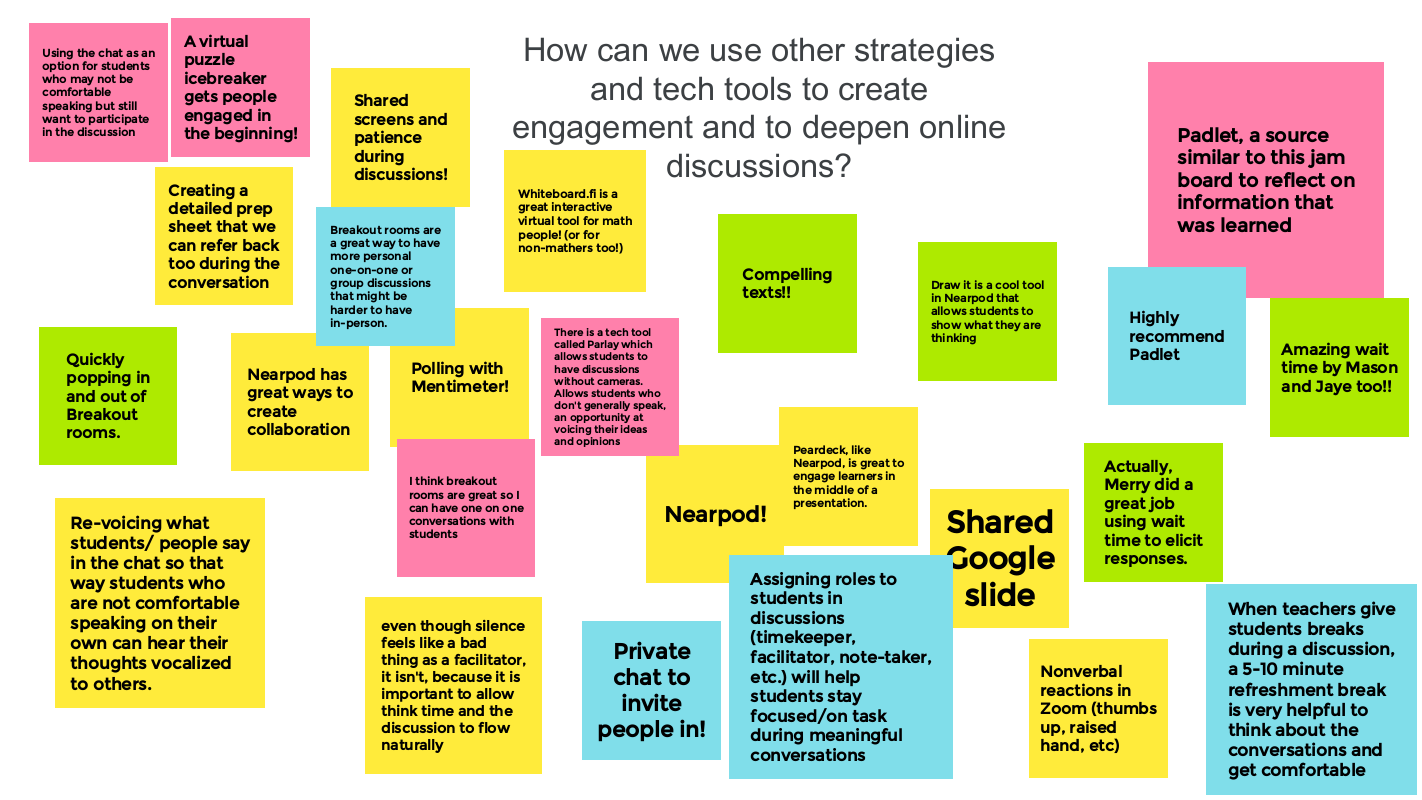
Using silence as a tool in conversational spaces
Kathy: I want to make a couple of observations about our list. A number of people have talked about silence.
And commenting that some of the facilitators [in the Breakout Rooms] used silence in a really thoughtful way.
Silence is oftentimes uncomfortable for us.
And I know that in my classes, we talk about this as students. We talk about how they use silence as a way to encourage deep thinking.
And there are techniques that you can use. Sometimes we call that a turn and talk. If you sense that people are silent, instead of jumping in to save the conversation, which teachers often do if they feel there’s tension in the room, no one’s talking.
Instead, you could have a private chat with a student, or, as some of you are suggesting, have a three minute think time. Turn off your cameras.
Right? Think for three minutes, come back to the conversation. Get comfortable with silence. Use silence as a learning tool.
It’s a challenge, but it’s a wonderful one because it can be a productive way to learn how to be comfortable with one another.
Abby: One thing that I’ve done in the past to varying degrees of success is have students like an answer to a question in chat and then like pick one of their responses and ask if anyone wants to like, respond to that. And oftentimes that gets students thinking about like other students’ work. Then sometimes even the student who said it will like, well, no, that’s not what I meant. And so they’re sort of playing off of each other.
Kathy: Thank you, Abby. Yeah. Using the private chat is it’s a really interesting technique. A couple of people mentioned, you know, here, the comment and using the chat to invite people in when you’re face-to-face. Right.
I can look Merry in the eye and I can give her a little clue that I’d love to have her speak next, like, but I can also chat Merry. Private chat her and say, “Merry, I’m really looking forward to your comment.”
Of course, the challenge is you don’t want to have so many crosscurrents of conversations off screen that people’s attention is diverted. That’s why, if you notice in the norms, we often we ask people to remain on the screen. To close other screens to give their full attention to the conversation at hand.
Even more resources
So just as a way to end, I have been engaged in this work of having high quality, thoughtful discussions that are really grounded in mutual respect, collaboration and trust for the last five years or so. And I’ve done it in a way where I’m using the knowledge that I can gain and the partnership that I can create with students to do this work.
So here are some resources that I’ve pulled together that have been helpful for me. I’m sharing them all with you here.
There’s some articles I’ve written that have really been written with kids and about the kids that you have met today. Some icebreaker activities, some materials for helping students ask good questions, some other articles on civil discourse, these are some pretty thoughtful articles.
Next steps
And then finally, I have a website where I have all sorts of materials and videos about having discussions specifically what we call Harkness discussions. That said, they don’t have to be Harkness discussions, just high quality face-to-face or online discussions.
And as we close out, I want to say a special thank you to the kids who are here today.
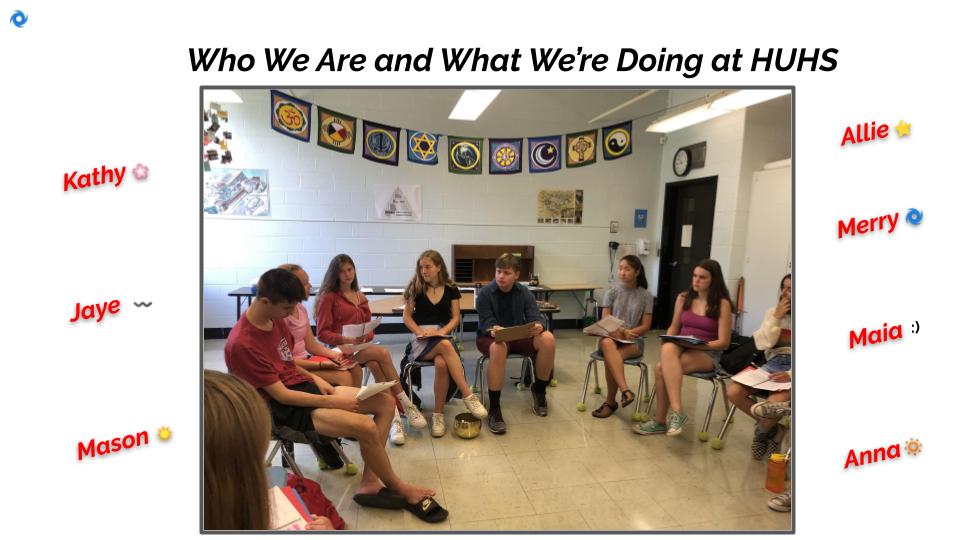
Thank you, Jay and Mason and Allie and Mary and Maya and Anna for taking time during school, online and after school. Thank you for sharing your time with us. And thank you for sharing your expertise.
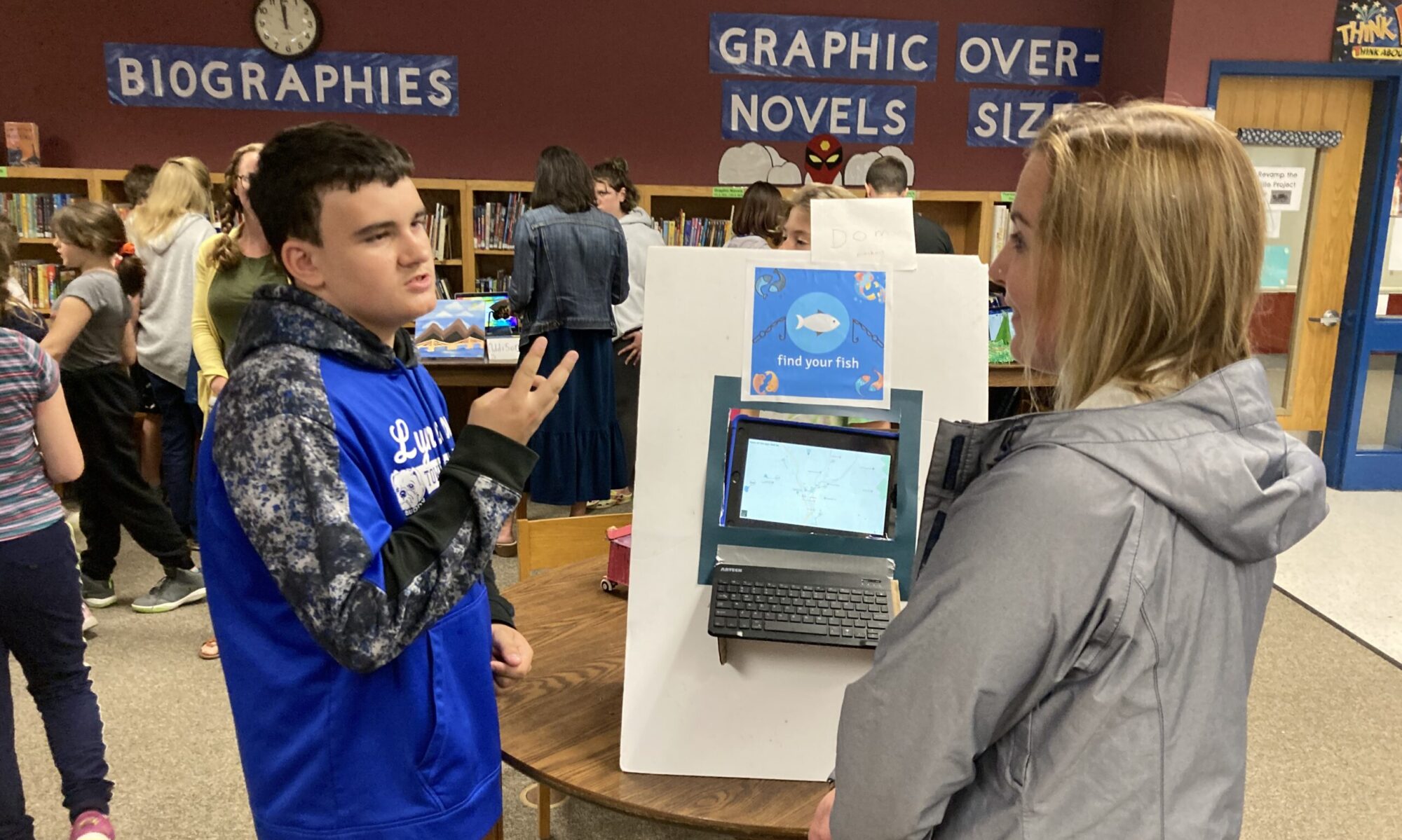



Nice Blog.thanks for sharing.
We are really grateful for your blog post. You will find a lot of approaches after visiting your post. I was exactly searching for. Thanks for such post and please keep it up. Great work
What a great content. The author has pitched the perefect points
This is very informative blog, keep sharing.
I went through your blog it is nice and informative.Keep sharing.
I read that Post and got it fine and informative.
Nice to read your article! I am looking forward to sharing your adventures and experiences.
Nice to read your article!
very good article Thanks,
you can buy uk gift card by your cryptos on our website
Great blog here! Also your site quite a bit up fast!. Absolutely awesome Article.l I could see how each stage works and its actually very straight forward.
Great blog here! Absolutely awesome Article.
Great post, you have pointed out some excellent points, I as well believe this is a very superb website.
Great post, you have pointed out some excellent points, I as well believe this is a very superb website.
Thirukadaiyur 60th Marriage online booking
We are arranging all types of homas, Poojas, Stay, food photography, videography, garlands, Thambulam, decoration and travel arrangements for you in the best manner.
thirukadaiyur temple official website
This is a very informative article, thanks Alot
The look rightly terrific. All these mini advice happen to be created implementing massive amount past working experience. I’d like to see the whole works very much.
Nice to visit your blog. It is full of with relevant knowledge and information. Looks fabulous, You’re definitely an inspiration and the way you’re always trying new things and sharing your work. I finally found a great post here. I really enjoyed reading this article. Thanks for sharing this valuable information. It’s difficult to find high-quality information. Share some more tips to organize things more better.
Thanks
Wonderful article. It’s very useful. As a home tuition service provider, I really appreciate your post. Thanks for sharing this with us. I find a very good website. Great Information sharing . I am very happy to read this article .. thanks for giving us go through info. Fantastic nice. I appreciate this post. I am happy to find your distinguished way of writing the post. Now you make it easy for me to understand and implement the concept. Thank you for the post.
Good post. I just stumbled upon your blog and wanted to say that I have really enjoyed reading your blog posts.
an interior designer with a passion for creating stunning, high-performing spaces that help real estate investors achieve their investment goals. With over a decade of experience in the industry, I specialize in multi-family value-add design that increases ROI and enhances tenant satisfaction.
I sincerely appreciate you sharing this, dear instructor.
I appreciate you sharing this, dear instructor.
Hello! I’m from the UK and will be travelling in October one way from San Francisco to Las Vegas. Free hold luggage and the low price leave me wondering whether there is a catch, if I missed something, or if this is just a truly fantastic value.
Thank you very much for sharing this, dear teacher.
Hello, I’m from the UK and will be travelling in October one way from San Francisco to Las Vegas. Free hold luggage and the low price leave me wondering whether there is a trap, if I have overlooked anything, or if this is just a truly amazing value.
For your lovely share, I really thank you, dear instructor.
Hello, I’m from the UK and will be travelling from San Francisco to Las Vegas in one direction in October. I’m wondering whether there’s a catch, if I’ve overlooked something, or if this is just a really excellent deal because it comes with free hold luggage and a great pricing.
Hello! I’m from the UK and will be travelling in October one way from San Francisco to Las Vegas. Free hold luggage and the low price leave me wondering whether there is a catch, if I missed something, or if this is just a truly fantastic value.
Fatih İstanbul Kocamustafapaşa semtinde bulunan Fatih Emlak Ofisi, kocamustafapaşa satılık daire hizmetlerini sunmaktadır. Uzman ekibimiz size en uygun daire seçeneklerini sunmak için burada. Siz de güvenilir bir emlak ofisi arıyorsanız, bizimle iletişime geçin.
Fatih İstanbul Kocamustafapaşa semtindeki emlak ofisimiz, satılık daire hizmetleriyle iddialıdır. Profesyonel ekibimiz size en iyi fiyatlarla kaliteli daire seçenekleri sunar. Sizin için en uygun olanı bulmak için bize başvurun.
Your post was inspiring and reassuring. Thank you for that.
Your post was very interesting.
Raj Comics By Sanjay Gupta is an imprint of Alpha Book Publishers started by Mr. Sanjay Gupta to expand the scope of superhero comic book universe, with the aim to entertain, motivate and augment the imagination of Indians across generations.
Thanks for sharing such an amazing piece of content. I’m truly impressed by the power and impact of digital marketing services in today’s business landscape. The way businesses are reaching their target audience, engaging with customers, and driving results through online channels is nothing short of remarkable.
Digital marketing services have revolutionized the way we promote products and services. The ability to tailor marketing campaigns to specific demographics and interests is a game-changer. With the wealth of data and analytics available, it’s now easier than ever to understand consumer behavior and adjust strategies accordingly. This level of precision allows businesses to get the most out of their marketing budgets and resources.
One of the key advantages of digital marketing services is the immediate feedback and real-time tracking they provide. Unlike traditional advertising, where you might wait weeks or even months to see results, digital marketing allows you to monitor campaign performance on a daily basis. This means that you can make adjustments as needed to optimize your efforts, which is incredibly valuable in a fast-paced, ever-changing online world.
Hallmark Builders’ Sunnyside in Manchirevula, Hyderabad offers premium 2 and 3 BHK apartments on a 6.5-acre site. With 2 BHK units ranging from 1250 to 1290 sq ft and 3 BHK units from 1650 to 2063 sq ft, it ensures spacious living. The project features amenities like parking, a banquet hall, a gym, indoor games, and recreational areas. It's designed for efficient waste management, sewage treatment, water conservation, and energy management. These high-quality apartments are conveniently located near schools, hospitals, and essential facilities, making it an ideal residential choice.
Great blog here! Absolutely awesome Article.
nice ninfot hanks
Your post was inspiring and reassuring. Thank you for that. Regards, Desugami
How is everything, and what you would like to say concerning this article, in my view its really remarkable for me.
nice info thanks
Thank You So Much for sharing.I have found it extremely helpful
To facilitate healthy and respectful conversations, encourage active listening, set clear ground rules for respect, and promote open-mindedness. Create a safe environment where all participants feel valued and heard.
Great post! Facilitating healthy and respectful conversations is crucial for fostering understanding and collaboration. I especially appreciate the tips on active listening and setting clear boundaries. These strategies can make a significant difference in how effectively we communicate and resolve conflicts. Thanks for sharing these valuable insights!
Hello
Instructor Kathy Cadwell of Vermont and her students from Harwood Union High School participated in the session “How to Facilitate Healthy & Respectful Conversations (Online & Off)” in March 2021. They exchanged tips on how to organize and lead productive online conversations, such as establishing expectations for online discourse and fostering a supportive learning environment in the classroom. In addition, the workshop covered common issues and offered tech advice for creating lively online communities with the goal of encouraging civil and cooperative online discourse.
Regards
David Warner
Hello
The workshop “How to Facilitate Healthy & Respectful Conversations (Online & Off)” in March 2021, led by Kathy Cadwell and her Harwood Union High School students, offered insights into managing virtual discussions. They addressed methods for fostering a supportive learning atmosphere in the classroom, creating guidelines for online discourse, and leading fruitful online conversations.
Regards
Nisha Marshall
Thank you for sharing this. I found it incredibly helpful!
mantap kali
Thanks for sharing
ESS Electrical Supply in Australia offers top-notch solutions for all your electrical needs. From reliable power distribution systems to high-quality components, ESS ensures your projects run smoothly and efficiently.
Thank you for sharing your expertise on this topic! I found your post to be informative and thought-provoking. You have a real talent for explaining complex ideas in a way that’s easy to understand.
Hello
This workshop sounds like a lot of fun! It’s critical that educators acquire the skills necessary to promote positive dialogue, particularly in online environments. It appears that Kathy Cadwell and her pupils offer insightful information that will be helpful to both educators and learners. I’d be interested in learning more about the methods they disclosed!
Regards
Nisha
We are really grateful for your blog post. You will find a lot of approaches after visiting your post.